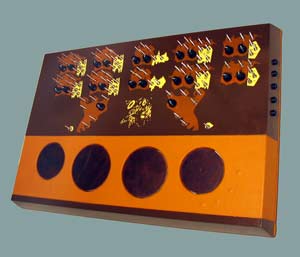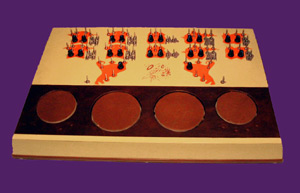Description | As the designer describes:
The tranoe, as it's called, combines the organic flows of a nabra (analog brain) with two very bendable ambraziers (8 bit digital delay). Using a system of alligator clips, you can connect any node (pin sticking up from the surface) to any node, and connect to as many external ins/outs as you want. There is no specific place to connect external devices to; you can connect anywhere you want! For example, you can use a drum machine to syncronize by connecting it to an input node, or you can listen to any part of the tranoe at an output node, connected to your mixer or amp. To make this possible, there are groundshares (plugs to connect the ground signal to) on the side of the instrument. It's easy to use cords with a 1/4" end and a groundshare/alligator clip end; all you need to do is connect the groundshares and then clip to any part of the tranoe. So you can put your tranoe into a stereo, octaphonic or whatever kind of network with the rest of the shtuff you work with. It' s perfect to experiment with because of its flexibility - you can use as small or as large parts of it as you want, in as simple or as crazy combinations as you want. You can even get crazy patching it without any fears: all inputs and outputs are protected from over current, so you can even randomly patch things together. The pin-style patching lets you patch with any kind of conductor- exposed wire, nails, worms. You can patch as many things you want to any one node, mixing output signals together by connecting them. And when you use alligator clips on it you have the advantage of parallel patching, which you don't get with serial patching schemes like banana plugs; When there's a bunch of things connected to one node, you don't have to take all the patches apart to disconnect one thing, which you do have to do with stackable banana plugs.
this instrument is not a closed system like the din datin dudero- that instrument has several electronic organisms that all feed and interact with each other and you play it by hacking into and disrupting the patterns. the tranoe is more classically patchable: the modules have inputs and outputs which are unconnected until you start wiring it up --- it's kind of like a workspace to build electronic organisms out of a few unique modules.
At night- the tranoe has glowing discs to indicate the state of its analog brain cells.
The "leatherside" of the tranoe. This is where you can control the 2 ambraziers (digital delays) of the tranoe. You can dynamically insert (anything from light layering to heavy punching in) any kind of signal or silence into each ambrazier. Directly above the leather section, there is a collection of nodes that control parameters of each ambrazier such as its speed, direction, and skip points.
the groundshares on the side of the tranoe- you simply connect the grounds of your audio system to here, and then you can listen to any part of the tranoe.
|




